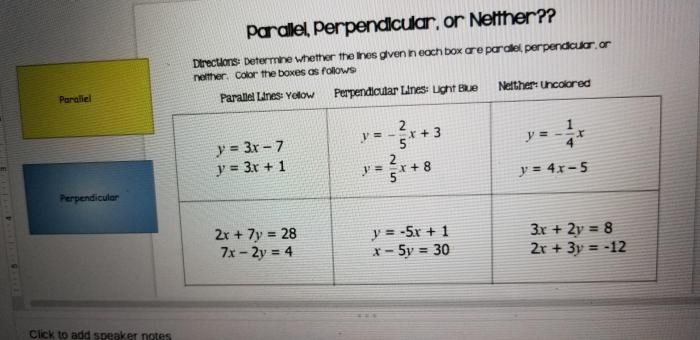Embark on an enlightening journey into the realm of geometry with our parallel perpendicular or neither worksheet, meticulously crafted to unravel the intricacies of line relationships. Delve into the distinct characteristics of parallel and perpendicular lines, and explore the nuances of lines that defy these classifications.
This comprehensive guide will illuminate the fundamental concepts, unveil real-world applications, and equip you with a robust understanding of these geometric principles. Prepare to sharpen your geometric acumen and embark on a path of discovery with our engaging worksheet.
Parallel Lines

Parallel lines are two lines that never intersect, no matter how far they are extended. They always remain the same distance apart.
Examples of parallel lines in everyday life include:
- The sides of a rectangle
- The rails of a train track
- The edges of a ruler
Properties of parallel lines include:
- They have the same slope.
- They are equidistant at all points.
- They never intersect.
Perpendicular Lines: Parallel Perpendicular Or Neither Worksheet
Perpendicular lines are two lines that intersect at a right angle (90 degrees). They are also called orthogonal lines.
Examples of perpendicular lines in everyday life include:
- The sides of a square
- The base and height of a triangle
- The spokes of a wheel
Properties of perpendicular lines include:
- They have different slopes.
- They intersect at a right angle.
- They divide each other into two congruent segments.
Neither Parallel nor Perpendicular
Lines that are neither parallel nor perpendicular are called oblique lines.
Examples of lines that are neither parallel nor perpendicular in everyday life include:
- The diagonal of a rectangle
- The hypotenuse of a right triangle
- The sides of a parallelogram
Properties of lines that are neither parallel nor perpendicular include:
- They have different slopes.
- They intersect at an angle that is not a right angle.
- They do not divide each other into two congruent segments.
Key Questions Answered
What is the difference between parallel and perpendicular lines?
Parallel lines never intersect, while perpendicular lines intersect at a right angle (90 degrees).
How can I identify lines that are neither parallel nor perpendicular?
Lines that are neither parallel nor perpendicular intersect at an angle that is not a right angle.
What are some real-world examples of parallel and perpendicular lines?
Parallel lines can be found in railroad tracks, while perpendicular lines can be found in the corners of a square.